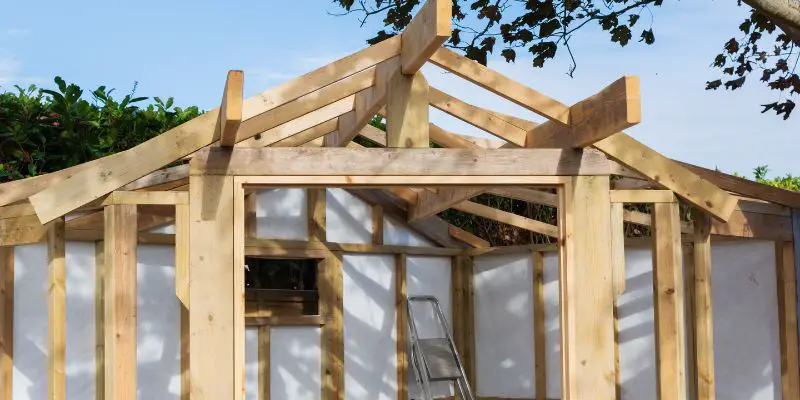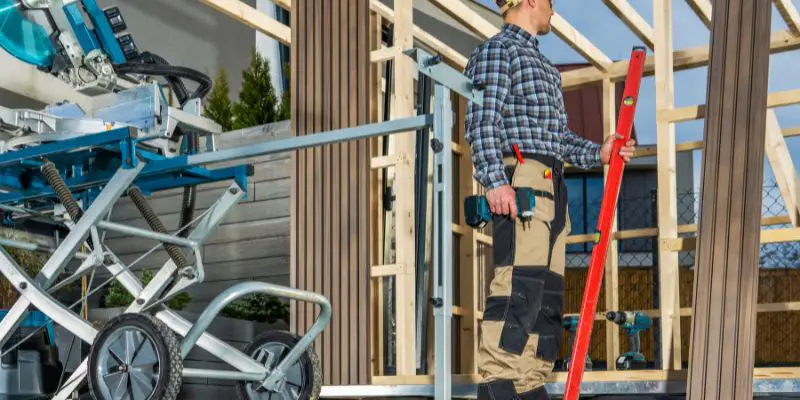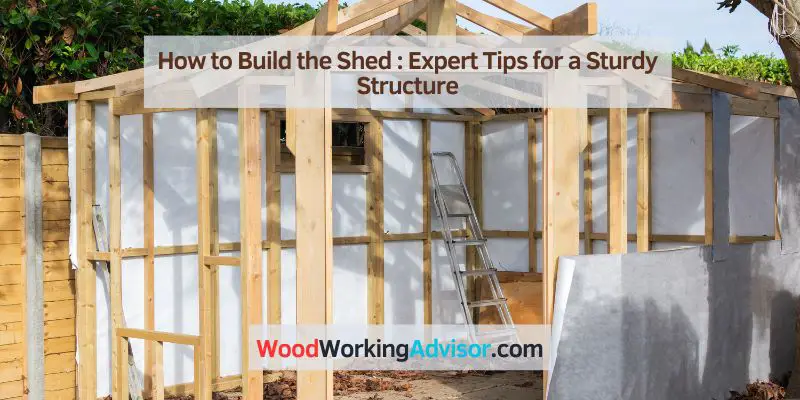To build a shed, start by selecting a suitable location, creating a foundation, and constructing the frame. Plan the layout, gather materials, and follow a step-by-step guide to ensure a successful build process.
Proper tools, safety precautions, and attention to detail are essential for a durable and functional shed that meets your needs. Building a shed is a practical and fulfilling project that provides valuable storage space and enhances your property. Whether you’re a skilled DIY enthusiast or a novice looking to expand your skills, constructing a shed can be achieved with the right approach and preparation.
By following a clear plan, utilizing quality materials, and staying organized throughout the process, you can create a reliable and attractive structure that adds value to your home. Let’s explore the essential steps and considerations for building a shed that meets your requirements.
Planning Your Shed Building Project
Embarking on a shed building project requires thorough planning, from choosing the right location and size to obtaining necessary permits and materials. Understanding the construction process is essential for ensuring a successful build, so consider factors such as foundations, framing, roofing, and siding.
Importance Of Thorough Planning Before Construction
Thorough planning is the bedrock of any successful shed building project. It ensures that every aspect of the construction process is carefully considered, from the selection of materials to the layout and design. A well-thought-out plan can save time, money, and frustration in the long run, making it a crucial step in the shed building process.
Choosing The Right Location For Stability And Functionality
Selecting the right location for your shed is paramount to its stability and functionality. A stable foundation is essential to support the weight of the shed and its contents. Additionally, the location should provide easy access while being strategically placed for optimal functionality.
Assessing The Purpose Of The Shed For Size Considerations
Understanding the purpose of your shed is vital in determining the appropriate size. Whether it’s storing garden tools, housing a workshop, or serving as a storage space, the size should be tailored to its intended use to maximize its utility.
Understanding Local Regulations And Permits
Before embarking on your shed building project, it’s imperative to familiarize yourself with local regulations and obtain the necessary permits. Failure to comply with local ordinances can result in fines and delays, so it’s crucial to adhere to these requirements.

Selecting Materials For Durability
When it comes to building a shed, selecting the right materials is crucial to ensure its durability and longevity. Factors such as weather resistance, sustainability, and quality play a key role in determining the lifespan of the structure. In this section, we’ll explore the various options for shed materials and consider their durability aspects.
Comparing Wood, Metal, And Plastic Sheds
Wood, metal, and plastic are the primary materials used for building sheds. Each material has its own set of advantages and considerations when it comes to durability.
- Natural aesthetics
- Prone to rot and insect damage without proper treatment
- Requires regular maintenance and resealing
- Durable and resistant to rot and insect damage
- Potential for rust and corrosion if not properly coated
- May be prone to dents and scratches
- Lightweight and low maintenance
- Prone to fading and degradation from UV exposure
- May not offer the same structural strength as wood or metal
Considerations For Weather Resistance And Longevity
When considering the durability of shed materials, it’s essential to factor in their weather resistance and longevity.
- Requires protective coatings to resist moisture and rot
- May degrade over time due to exposure to the elements
- Resistant to moisture, rot, and insect damage
- May require rust-resistant coatings for prolonged longevity
- Resistant to moisture and rot
- May degrade from prolonged UV exposure
Benefits Of Using Sustainable, High-quality Materials
Opting for sustainable and high-quality materials offers numerous benefits in terms of durability and environmental impact.
- Minimizes environmental impact
- Supports eco-friendly construction practices
- Promotes responsible use of resources
- Enhances longevity and durability of the shed
- Reduces the need for frequent repairs or replacements
- Provides a sturdier and more reliable structure
How To Build The Shed: Laying A Solid Foundation
Building a shed involves a number of crucial steps, and laying a solid foundation is at the top of the list. The foundation sets the stage for the entire structure, providing stability and support. In this guide, we’ll delve into the importance of a solid foundation, walk you through the step-by-step process of preparing the ground and creating a base, and share valuable tips for ensuring a level and stable foundation.
Explaining The Role Of A Solid Foundation For The Structure
A solid foundation is essential for any structure, including a shed. It serves to distribute the weight of the shed evenly, preventing shifting, settling, and potential damage. Additionally, a well-built foundation helps to minimize moisture infiltration, which can lead to rot and decay. By providing a level and stable base, a solid foundation ensures the longevity and durability of your shed.
Step-by-step Guide To Preparing The Ground And Creating A Base
Before you begin construction, it’s crucial to prepare the ground properly for the foundation. Here’s a step-by-step guide to help you through the process:
- Clear the area: Remove any vegetation, rocks, or debris from the site.
- Mark the perimeter: Use stakes and string to outline the dimensions of the shed.
- Excavate the site: Dig down to the recommended depth, ensuring the ground is level.
- Create a base: Add a layer of gravel or crushed stone for drainage and stability.
Tips For Ensuring A Level And Stable Foundation
When laying the foundation for your shed, it’s important to pay attention to detail to ensure a level and stable base. Here are some tips to help you achieve this:
- Use a spirit level: Regularly check the levelness of the ground and the base as you progress.
- Compact the base: Use a hand tamper or plate compactor to ensure the base is firmly packed.
- Consider drainage: If the area is prone to water accumulation, incorporate proper drainage solutions into the foundation design.
- Use quality materials: Invest in high-quality gravel, crushed stone, or concrete to create a durable foundation.
Expert Tips For Framing And Walls
Best Practices For Constructing A Robust Frame
When building a shed, the frame is the backbone of the structure, providing stability and support. Ensure the following best practices for constructing a robust frame:
- Use pressure-treated lumber to resist rot and insect damage.
- Implement proper bracing techniques to prevent warping and ensure structural integrity.
- Ensure accurate measurements and square corners for a sturdy and precise frame.
- Consider using advanced framing techniques to minimize waste and increase energy efficiency.
Techniques For Erecting Walls That Withstand The Elements
Strong and durable walls are essential for withstanding the elements and maintaining the integrity of your shed. Consider the following techniques for erecting walls that withstand the elements:
- Use high-quality exterior sheathing to protect against moisture and enhance structural strength.
- Apply proper flashing and sealing around windows, doors, and other openings to prevent water intrusion.
- Utilize advanced fastening methods to securely attach the walls to the frame and ensure stability.
- Consider incorporating diagonal bracing or shear panels for increased stability and resistance to wind forces.
Advice On Insulation And Ventilation For Shed Longevity
Insulation and ventilation are crucial for maintaining a comfortable and durable shed. Consider the following advice on insulation and ventilation for shed longevity:
- Choose insulation materials with high R-values to maximize energy efficiency and climate control.
- Properly insulate and seal the walls, roof, and floor to prevent thermal bridging and air leakage.
- Install adequate ventilation, such as ridge vents or soffit vents, to minimize moisture buildup and promote air circulation.
- Consider adding a vapor barrier to control condensation and protect against moisture-related issues.
Roofing Essentials For A Sturdy Structure
When it comes to building a sturdy shed, the roofing is one of the most critical aspects to consider. A well-constructed roof not only provides protection from the elements but also adds to the overall durability and longevity of the structure. It’s essential to understand the roofing essentials for a sturdy structure to ensure that your shed can withstand various weather conditions and remain functional for years to come.
Exploring Different Roofing Styles And Their Benefits
Before starting on the roofing for your shed, it’s important to explore the different roofing styles available and consider their benefits. Here are a few common roofing styles and their advantages:
- Gable Roof: Provides excellent water drainage and ventilation, making it suitable for areas with heavy rainfall.
- Flat Roof: Offers a modern and minimalistic appearance, ideal for small sheds and urban environments.
- Gambrel Roof: Maximizes interior space and provides a classic barn-like aesthetic.
How To Install A Weatherproof Roof
Installing a weatherproof roof is crucial for ensuring the longevity of your shed. Here are the essential steps for installing a weatherproof roof:
- Select High-Quality Materials: Choose durable roofing materials such as asphalt shingles, metal roofing, or rubber membrane to withstand harsh weather conditions.
- Proper Installation: Ensure that the roofing materials are installed correctly, with waterproofing measures taken at all seams and edges to prevent water infiltration.
- Good Drainage: Install gutters and downspouts to channel water away from the shed and prevent pooling on the roof surface.
- Regular Maintenance: Inspect the roof periodically for any signs of wear and tear, and promptly address any issues to maintain its weatherproofing capabilities.
Preventing Leaks And Maintaining Your Shed’s Roof Over Time
To prevent leaks and maintain your shed’s roof over time, consider the following measures:
- Seal Potential Entry Points: Seal any gaps or openings in the roof and around vent pipes to prevent water intrusion.
- Trim Overhanging Branches: Keep tree branches trimmed to prevent debris buildup and minimize the risk of damage to the roof during storms.
- Regular Inspection: Conduct regular inspections of the roof to identify and address any potential issues before they escalate.
- Clean Gutters: Keep the gutters clean to ensure proper water drainage and prevent blockages that could lead to water seepage.

Final Touches: Doors And Finishing
As you near the completion of your shed building project, it’s time to focus on the final touches that will not only enhance the functionality of the shed but also add to its overall aesthetic appeal. This section will cover the crucial aspects of selecting and installing doors, adding personalized features for functionality, and applying finishes for both aesthetic appeal and protection.
Selecting And Installing Doors For Security And Ease Of Access
When it comes to selecting doors for your shed, it’s essential to prioritize both security and ease of access. A sturdy, secure door will protect your belongings while also providing convenient entry and exit points. Opt for doors made of durable materials such as steel or solid wood. Consider installing a deadbolt or other security features to further safeguard your equipment and tools.
- Choose a door that complements the overall design of your shed.
- Ensure proper measurements to guarantee a snug fit for the door.
- Install heavy-duty hinges for added strength and longevity.
How To Build The Shed: Adding Personalized Features For Functionality
Personalizing your shed with features tailored to your specific needs can significantly enhance its functionality. Whether it’s additional shelving for storage, built-in workbenches, or customized tool racks, these personalized touches will make your shed a practical and efficient workspace. Consider the layout of your shed and optimize its design to maximize utility.
- Assess your storage and workspace requirements.
- Plan and implement personalized features that align with your workflow.
- Customize the interior to accommodate your tools and equipment efficiently.
Steps For Applying Finishes For Aesthetic Appeal And Protection
Applying finishes to your shed serves a dual purpose – enhancing its visual appeal and providing a protective barrier against the elements. Whether you opt for paint, stain, or sealant, proper application is crucial to achieve a polished and durable finish. Prioritize weather-resistant finishes to ensure the longevity of your shed’s exterior.
| Finishing Step | Description |
|---|---|
| Clean and Prep | Thoroughly clean the surface and ensure it’s free of dust and debris before applying any finish. |
| Application | Apply the chosen finish evenly using appropriate tools, following the manufacturer’s guidelines. |
| Drying and Curing | Allow ample time for the finish to dry and cure, ensuring it’s fully set before subjecting it to use or weather exposure. |
Frequently Asked Questions On How To Build The Shed
Is It Cheaper To Build Your Own Shed?
Yes, building your own shed can be cheaper than buying a pre-built one, as you save on labor costs and have control over materials. By doing it yourself, you can also customize the shed to fit your specific needs and preferences.
How To Build A Shed Step By Step?
To build a shed, start by laying a solid foundation. Then, frame the walls and roof, and install siding and roofing. Finish by adding doors, windows, and any desired trim. Customize the interior to suit your needs. Lastly, ensure the shed complies with local building codes.
What Are The 7 Steps To Building A Shed?
The 7 steps to building a shed are: 1. Plan and prepare the site. 2. Build the foundation. 3. Frame the walls and roof. 4. Install doors and windows. 5. Add siding and roofing. 6. Finish the interior. 7. Paint or stain the exterior.
How Much Does It Cost To Build A 12×12 Shed Yourself?
The cost to build a 12×12 shed yourself can range from $500 to $3000 based on materials and design.
Conclusion
Building a shed can be a rewarding and practical project for any homeowner. With the right tools, materials, and a clear plan, you can create a functional space that meets your needs. By following the steps outlined in this guide, you can confidently embark on your shed-building journey and enjoy the results for years to come.



One thought on “How to Build the Shed : Expert Tips for a Sturdy Structure”